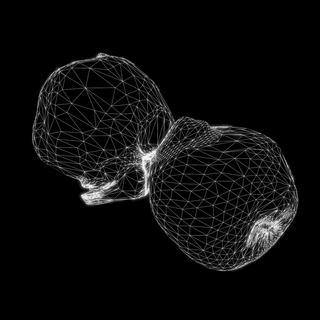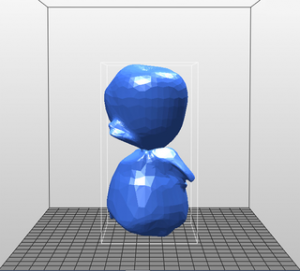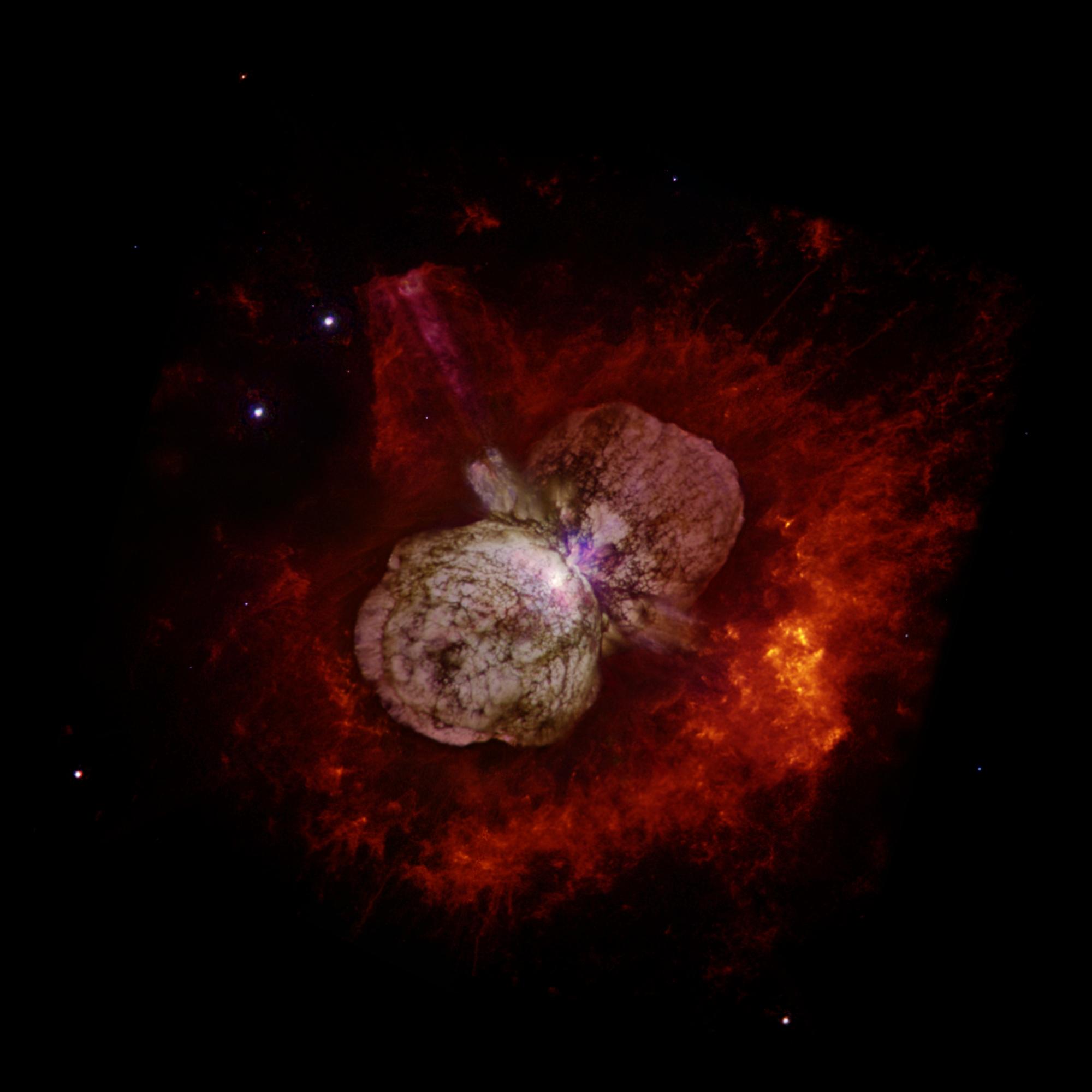Somewhere around 5,500 BC, the binary star system Eta Carinae experienced a massive eruption, shooting material at least ten times the mass of the sun, and possibly as much as 40 times as much, into the universe. This eruption made it the second brightest star in the sky from 1838 to 1845, approximately 7,500 years later. Astronomers termed this unusual activity ‘The Great Eruption’ and the material cloud that was formed has been named the Homunculus Nebula. It’s no small fry either, currently measuring approximately one light year in length and continuing to expand at the breakneck speed of 1.3 million mph.
Prior to this most recent modeling effort, a set of assumptions was being made about the symmetrical nature of the dust cloud impacting the kind of information they were able to gather about it. In March of 2012, Ted Gull and Tom Madura, NASA Goddard astrophysicists, in conjunction with other researchers, used the aptly named European Southern Observatory’s Very Large Telescope and its X-Shooter Spectrograph to measure the near-infrared, visible, and ultraviolet wavelengths. With this data, they were able to make the most complete spectral map of the system that has ever been created.
The binary system has been subject to a great deal of attention in the past. However, when astronomers were working with space telescopes as their primary means of observation they were only able to see the shape of the nebular cloud in the dusty portions. In addition, even after more advanced spectrographic techniques were introduced, only five ‘slices’ of the binary’s body were captured in data and the rest was extrapolated from that based on a set of assumption. This latest set of observations captured nearly 100 slices, allowing for much greater depth of detail and therefore fewer assumptions. With this data, they were able to create a full 3 dimensional model in high resolution.
 Wolfgang Steffan, an astrophysicist at the Ensenada campus of the National Autonomous University of Mexico described the translation of this data into the 3D model:
Wolfgang Steffan, an astrophysicist at the Ensenada campus of the National Autonomous University of Mexico described the translation of this data into the 3D model:
“Our next step was to process all of this using 3D modeling software I developed in collaboration with Nico Koning from the University of Calgary in Canada. The program is simply called ‘Shape,’ and it analyzes and models the three dimensional motions and structure of nebulae in a way that can be compared directly with observations.”
In other words, rather than relying on assumptions about how this particular eruption might have been manifest, the data can actually be translated into a physical model that can be directly examined. Taking that data one step further, it was converted into a format ready for 3D printing so that they could hold their object of study in their hands. They also released the 3D print file along with their published paper. Gull noted:
“Now anyone with access to a 3D printer can produce their own version of this incredible object. While 3D printed models will make a terrific visualization tool for anyone interested in astronomy, I see them as particularly valuable for the blind, who now will be able to compare embossed astronomical images with a scientifically accurate representation of the real thing.”
In this statement, Gull shows an understanding of the potential for 3D printing as both an education tool and as a mechanism for broadening the experiences available to assist the vision impaired, in keeping with a number of recent innovations in that area both inside and outside of NASA.
 The model that was created confirmed some observations as well as introducing others. For example, it has been supposed that pronounced holes exist at the ends of each lobe of the binary and now those holes have been confirmed. The scientists discovered through this process some new features such as unexpected protrusions, deep trenches, and a series of irregular divots. One of the most interesting aspects of the in depth study of this system is the realization that the binarity of the stars played a role possibly both in the explosion itself and the in shaping the nebula. Further understanding of this will help to reveal more about the inner workings of stars and to recognize other potentially binary systems based on their distinct nebulae.
The model that was created confirmed some observations as well as introducing others. For example, it has been supposed that pronounced holes exist at the ends of each lobe of the binary and now those holes have been confirmed. The scientists discovered through this process some new features such as unexpected protrusions, deep trenches, and a series of irregular divots. One of the most interesting aspects of the in depth study of this system is the realization that the binarity of the stars played a role possibly both in the explosion itself and the in shaping the nebula. Further understanding of this will help to reveal more about the inner workings of stars and to recognize other potentially binary systems based on their distinct nebulae.
This project demonstrates the ways in which 3D technologies not only capture what we can imagine, but also can teach us about what we could not. Let us know what you think about this use of 3D printing in the Homunculus Nebula forum thread on 3DPB.com. Further details on this amazing model and 3D print can be found in the video below:
Subscribe to Our Email Newsletter
Stay up-to-date on all the latest news from the 3D printing industry and receive information and offers from third party vendors.
You May Also Like
3D Printing News Briefs, April 13, 2024: Robotics, Orthotics, & Hypersonics
In 3D Printing News Briefs today, we’re focusing first on robotics, as Carnegie Mellon University’s new Robotics Innovation Center will house several community outreach programs, and Ugogo3D is now working...
Rail Giant Alstom Saves $15M with 3D Printing Automation Software 3D Spark
3D Spark has entered into a three-year deal with the rail giant Alstom. Alstom, a transport behemoth with annual revenues of $16 billion, specializes in the manufacture of trains, trams,...
Meltio Expands Global Reach with New Partnerships in the Americas and Europe
Spanish 3D printing manufacturer Meltio has expanded its sales network across the globe. With the addition of three new partners in the United States, Brazil, Argentina, and Italy, Meltio aims...
3D Printing Webinar and Event Roundup: April 7, 2024
Webinars and events in the 3D printing industry are picking back up this week! Sea-Air-Space is coming to Maryland, and SAE International is sponsoring a 3D Systems webinar about 3D...
































